Roman Moser (Theme 2)
This Blog explains the fundamentals of the vehicle to grid technology and its relevance for the energy transition in the mobility sector. It discusses the newest projects and chances for this technology to be implemented in Switzerland. Today, we have the technologies to solve climate change and move towards a sustainable and renewable energy system. Regarding the SDG’s this technology has an impact to Nr.7 (affordable and clean energy), Nr.9 (industry, innovation and infrastructure), Nr.11 (sustainable cities and communities, Nr.13 (climate action) and Nr.16 (peace, justice and strong institutions)
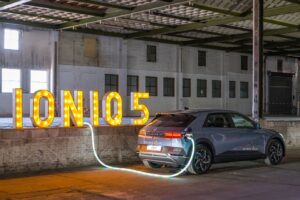
Figure 1 Hyundai IONIQ 5 (Hyundai, 2022)
We Drive Solar, a Dutch mobility provider in Utrecht and strategic partners, announced to be the first region globally with a fleet of battery electric vehicles (BEV) that can be charged and discharged back to the grid. With this unique vehicle to grid technology based on the ISO15118 protocol for AC bidirectional charging, We Drive Solar can use the BEVs to store and reuse renewable energy in mobile batteries. (Utrecht-Region, 2022) Utrecht has nowadays over 1000 bidirectional charging stations installed. Therefore, charging and discharging is possible over the whole region. (Hyundai, 2022)
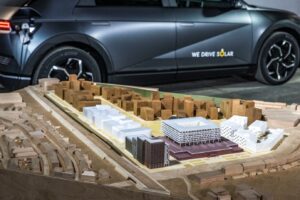
Figure 2 Residential building project (Hyundai, 2022)
Hyundai Motor and We Drive Solar have launched a new mobility project for a new residential building project with up to 2350 homes in the neighbourhood next to Utrecht. The public space is implemented with smart mobility concepts for residents. The key role of Hyundai Motor and We Drive Solar is to provide a mobility service which includes shared electric cars like the IONIQ 5 for the residents. We Drive Solar is playing a key role in building up the future renewable energy ecosystem for Utrecht. In addition, the IONIQ 5 from Hyundai will act as one of the first bidirectional production cars which can feed back electricity to the grid while the car is not used for moving residents. The project starts with 25 Hyundai IONIQ 5 and during the course of 2022 over 150 will follow. The project aims to make Utrecht the first region with a bidirectional energy ecosystem. Solar and wind power can be stored and buffered in car batteries and help the grid system to work with sustainable electric power. (Hyundai, 2022)
What is bidirectional chargingand what can it be used for?Bidirectional charging can be used in many terms. Vehicle to everything V2X is the general term to describe the added functionality to an electric car which can feed back electricity. Electric vehicles can power homes (V2H) or buildings (V2B) or loads (V2L). (Hyundai, 2022) The term vehicle to grid (V2G) represents the technology that allows bidirectional energy transfer between electric vehicles and the grid itself. In this way, an electric vehicle can be utilized as a mobile battery and can be used for decentralized renewable energy production. This can result in reduced costs of energy and generate an additional revenue stream. (V2G- Hub, 2022)
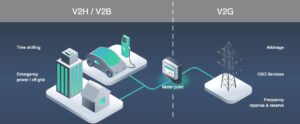
Figure 3 V2X Overview (V2G-Hub, 2022)
Benefits for EV owners
The power which is stored in the batteries can be feed back to the grid and will be paid off. Therefore an EV owner can generate a revenue stream from its car which is standing for the most time of the day. If a homeowner has a solar production plant on its roof, self consumption of this produced energy can be stored in the battery. In the evening and night times, this stored energy can be used directly from the batteries instead of buying the power from the grid. Reduced costs of the electricity and a faster payback time are the results.
Benefits for local electricity providers
As a network and system operator from the local grid, V2G can help these providers to manage the whole system and its loads. If the electricity demand and supply can be regulated in a local network, the providers can avoid the need for costly network upgrades, because the energy can be shifted within the local grid. Extra flexibility and a wider range of the product portfolio are other benefits for the local electricity providers.
Products V2G can be used for
In an electric system, the supply and demand of electricity must be balanced all time. There is a supply gap when a power station shuts down. Electric vehicles which are connected to a V2G charging station can help fill this gap, by pausing the charging process and additionally exporting the electricity stored in the battery. Due to the fast reaction speed, the EVs and battery systems have, frequency regulations can take place with response times from seconds to start charging and increase the demand side or provide power from the batteries over hours on the supply side.
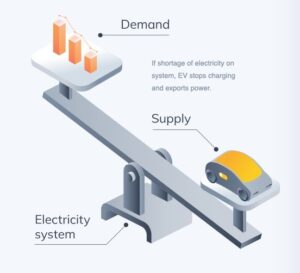
Figure 4 Electric system supply and demand (V2G-Hub, 2022)
On the open electricity market, prices fluctuate during the day. On a sunny day, electricity is cheap during the daytime but results in higher prices when the sun is not shining anymore. With the process called arbitrage, this electricity can be bought at low prices and can be sold in the evening when prices are high again.For distribution operators, V2G can play a major role in shifting the peak times. Network equipment is expensive and is rated on a certain capacity. At peak times when businesses and homes are consuming the most power, this capacity level can be exceeded. Instead of investing a high amount into infrastructure V2G can help to shift these peak demands. V2G technology can provide extra power from local EVs to the grid and the need for importing more energy is reduced. In an emergency case where the grid is shut down due to a power outage, EVs can be used as a backup energy source. The bigger batteries in EVs can store much more electricity than current home batteries. An off-grid setting on the house side will then allow using of the EV battery to provide electricity for all electric systems in a household over a much longer time. (V2G-Hub, 2022)
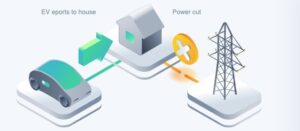
Figure 5 Power outage (V2G-Hub, 2022)
V2G will play a major role in energy transition all around the globe. For Utrecht and We Drive Solar it is not the first project in the V2G space. Smart Solar charging is an ongoing project with Renault to show that the technology can already be implemented in the market. (USI, 2019) In the United States of America, a simulation analyses shows that revenue streams from V2G operations can be achieved. With a Nissan Leaf that can use a battery capacity of 24 kWh and a 3.3kW charger, it was possible to produce an annual revenue of $318 – $454.26 when de driving distance per day was reduced from 60 to 20 miles or 95 to 33 kilometers (Z. LI1), 2014)
What’s happening in Switzerland in V2G
In Switzerland, we have a milestone project from V2X Suisse. The car sharing company Mobility in combination with the software provider Sun2wheel and charging station producer EVTEC are building the environment to use the V2G technology in Switzerland. This project aims to gather information about grid stability capabilities and how to optimize self- consumption from photovoltaic systems. Additionally, the economic potential of bidirectional vehicles in Switzerland is investigated. The project is now in the start-up phase and will officially start in September 2022. (Sun2wheel, 2022)
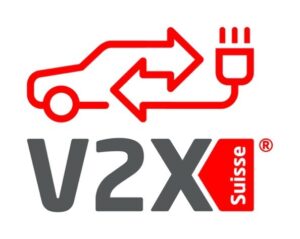
Figure 6 V2X Suisse project (Sun2wheel, 2022)
Conclusion
As mentioned in the above, V2G can and will play a major role in climate action with the transition towards green mobility and green electricity grid. It provides innovations for the whole energy industry. The projects lead to the implementation of new technologies and therefore boost more affordable and green energy around the world. Moreover, V2G will help cities and communities to be more sustainable because renewable energy can be used and stored locally.
References
Sun2wheel. (19. 01 2022). V2X Suisse – Das Mega-Projekt der Sektorkopplung. Von https://sun2wheel.com/blog/v2x-suisse-das-mega-projekt-der-sektorkopplung/ abgerufen
V2G-Hub. (21. 04 2022). Service. Von https://www.v2g-hub.com abgerufen
Hyundai. (2022, 04 21). Hyundai and We Drive Solar launch energy system of the future in Utrecht. Retrieved from https://www.hyundai.news/eu/articles/press- releases/hyundai-and-we-drive-solar-launch-energy-system-of-the-future-in- utrecht.html
Utrecht-Region. (21. 04 2022). We Drive Solar, An inventive durable energy and mobility system. Von https://www.utrechtregion.com/discover-utrecht- region/sustainability/we-drive-solar abgerufen
USI. (21. 03 2019). Utrecht sustainable institute. Von https://usi- nl.translate.goog/persbericht-koning-willem-alexander-opent-bidirectioneel- ecosysteem-in-utrecht/?_x_tr_sl=nl&_x_tr_tl=en&_x_tr_hl=en&_x_tr_pto=sc abgerufen
LI1), M. C. (2014). OPTIMIZING THE PERFORMANCE OF VEHICLE-TO-GRID (V2G) ENABLED BATTERY ELECTRIC VEHICLES THROUGH A SMART CHARGE SCHEDULING MODEL. International Journal of Automotive Technology, 827−837.
Figure 1 Hyundai IONIQ 5 (Hyundai, 2022)
Figure 2 Residential building project (Hyundai, 2022)
Figure 3 V2X Overview (V2G-Hub, 2022)
Figure 4 Electric system supply and demand (V2G-Hub, 2022)
Figure 5 Power outage (V2G-Hub, 2022)
Figure 6 V2X Suisse project (Sun2wheel, 2022)